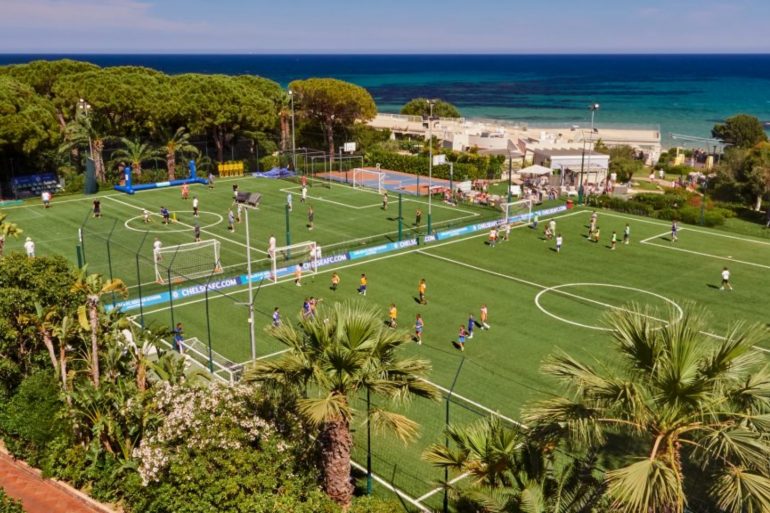Football: the story of the most famous sport in the world
Football: the story behind the oldest game in the world
Football is the most common, loved and played sport in the world, it has about 4 billion fans spanning every nationality and an incredible business around it. This sport is among the most ancient and its popularity is still in continuous growth.
Football has the biggest number of championships in the world and there are some legendary footballers and teams which have made history in this discipline, for example the players of the Chelsea F.C, some of which provide training at the Chelsea Foundation Soccer Camp at Forte Village, an academy for young footballers ranging from 4 to 14 years old.
The game in Italian is called Calcio which comes from the Latin Calx Calcis, which translates to “heel” and its origins are very ancient. It would appear there was a game in Japan very similar to football during the XI century BC, meanwhile in China between the III and II century BC, Ts’u-Chü (ball moved with feet) was a military training consisting of a ball filled with feathers and hair which had to be kicked beyond two bamboo canes.
According to a manuscript kept in Monaco dating back to 50 BC, Ts’u-Chü was later introduced to Japan where they organized a series of matches between both Asian countries. Ts’u-Chü was recognized by the Fédération Internationale de Football Association, also known as FIFA, as the ancestor of football as we know it today.
In the country of the rising sun, more or less 500 or 600 years after Ts’u-Chü, another sport similar to football called kemari began to be played, and became very popular during the Heian period. Players of kemari were allowed to use their heads, feet, knees, back and elbows with the objective to keep the ball, called Mari, from ever touching the ground.
The history of football continues in Greece during the IV century, where they played Episkyros, a game recognized as the grandfather of European football and rugby. The Episkyros game was formed by two teams with 12 or 14 players each, throwing a ball with their feet or hands. In Ancient Greece there where other games involving a ball including Urania, the feninda and aporraxis.
Episkyros was later played in Rome and renamed Harpastum, a Latin translation from the term harpastón, meaning “torn with force”, “taken away”. The ancient Romans also used the expression “game of the little ball” because of the small dimensions of the spherical ball filled with wool or tow. It was the favourite game of the troupes stationed along the border and also part of the training of gladiators.
Football: France and England during the Middle Ages
During the Middle Ages Soule, a team sport not so different from our modern football, was played in France, especially in the area between Normandy and Piccadilly.
Soule had precise rules and was played either by entire villages against one another or opposite status, for example married against singles, every Sunday after the religious functions.
The dimensions of the field would vary according to the number of players forming the teams, anyhow they were much larger than the modern fields. The areas they used included rivers, ditches, streams or bogs. To mark the center of the pitch there could be a village square, a cemetery, the churchyard or the castle of the local lord.
The ball was made of leather and filled with grains, hay, moss or horse hair, the objective was to push the ball into the adversaries territory by using hands, feet or even sticks. A great deal of tenacity and effort was necessary to reach the goal and sometimes the game would involve competitions of boxing during the matches.
The first documentation relative to Soule in French grounds dates back to 1147, but experts believe the game already existed before 1000. One hypothesis shared by many historians is that the introduction and diffusion of Soule in England was connected to the Norman invasion in XI century.
Football wasn’t immediately well received in Great Britain because it was considered violent. In 1314 king Edward banned the game in public spaces and in 1338, during the war of 100 years, Henry the V banned it definitively and preferred archery. The sport was reintroduced in 1835 when Higway Act allowed the games to be played in closed spaces.
Football: renaissance Florentine football
The Crusca dictionary, printed in Venice in the XVIII century, describes football which will conquer Florence with the following words:
“Football is also name of game, owned and part of the ancient tradition of Florence, a way of ordered battle with a ball in the wind, similar to sferomachia, passed from the Greeks to the Latins and from the Latins to us”
Florentine football, also known as “football in livery” or “football in costume”, is a sport formed by white or green teams against each other. Later the teams became four, one for each district of the city: Santa Maria Novella (red), Santa Croce (blue), San Giovanni (green), Santo Spirito (white).
Originally each team was formed by 27 players divided into the following categories:
- 15 front line players divided into 3 groups of 5, who were strikers called Innanzi
- 5 players, called sconciatori, formed the second line and were an obstacle for the adversaries game
- 4 footballers, the datori innanzi, made the third line and threw the ball back to the innazi
- 3 players, the datori behind, were obstacles for the innanzi of the opposite team
Florentine football is performed today as an historical revocation, with the traditional and unique costumes. A similar game was also played in Venice, Bologna and Prato.

Football: modern football comes from England
To know more about the origins of modern football it is necessary to go back in time, to England in 1617, when the sport was played by college and university young students. The teams were made up of 10 students each and the master was the goal keeper.
This is how the layout of the contemporary football teams was born, with 10 outfield players and the goalkeeper who replaced the master as captain of the team. The goalkeeper is recognizable by the shirt, which is always a different color from the outfield players shirt, and the captain wears an armband around his bicep.
In England the rules of another game, called dribbling-game, an ancestor of football and rugby, were also invented and consisted in matches with 11 or 22 players. The difference between the two sports caused the separation between the games leading to Rugby Union in 1846 and on the 24th of October 1857 the Sheffield Football Club, first football club in the world, was founded.
The beginning of modern football is marked by Ebenezer Cobb Morley founding FA, acronym of Football association on the 26th of October 1863, the oldest football federation in the world.
Football: the most important dates in contemporary football
Let’s now discover together the events which have marked the beginning of the contemporary game:
- 1870: worldwide, still today, the deployment of each team in the field was formed by a goalkeeper, two full-backs, three medians and five strikers.
- 1871: the ball measurement was defined, and the goalkeeper became the only player allowed to use his hands during a match. The Scottish federation was established.
- 1875: the federation in Wales was established
- 1878: the referee uses a whistle for the first time during a match
- 1886: the International Football Association Board (IFAB), international association holding four members was founded: England, Scotland, Ireland and Wales. The players work is recognized professionally with the same importance as other professions, allowing them to dedicated more time into their practice and be compensated for their service.
- 1890: nets are put on the goals
- 1891: the New Zeland football Federation was founded, followed by South Africa, Argentina, Belgium, Chili, Switzerland, Italy and Germany.
- 1889: the first championship was played in England with classified double round-robin matches
- 1892: penalties become a part of the games rules
- 1902: the first game played between two nations: Austria and Hungary
- 1904: FIFA, Fédération Internationale de Football Association was founded
- 1920: first edition of the Olympics recognized by FIFA
- 1928: FIFA organizes World Cup competitions which are still played regularly every four years.
- 1955: UEFA Champions League was established
- 1960: Copa Libertadores for Latin America teams was founded
- 2016: in Bari, slow-motion was used for the first time during the match between France and Italy. That same year in December, during the finals of the World Cup, Real Madrid makes the fourth substitution. For the first time in the history of football the changes are not limited to three.
- 2017: Neymar, playing in Barcellona, passes to Paris Saint-Germain Football Club for 222 million euros, the most expensive transfer in the history of this game.






